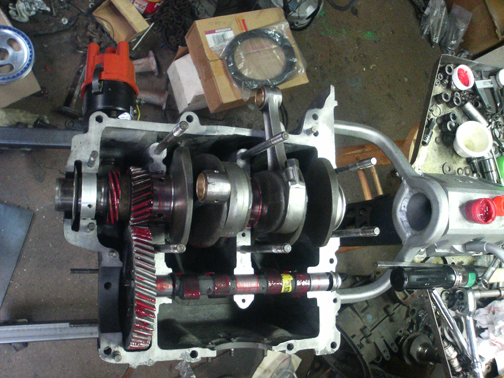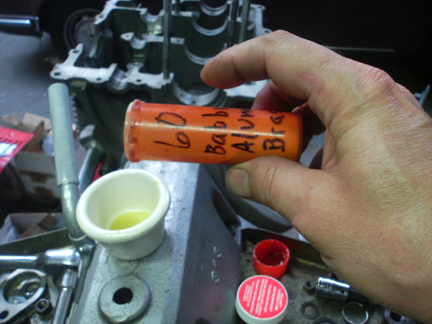Copyright © 2007 - 2025, Coachworks For contact data Click Here.

Copyright © 2007 - 2025
Copyright © 2007 - 2025,
Coachworks For contact data
Click Here.

The following was sent to the Karmann Ghia Club of North America's email list on August 18th, 2009:
Well, ten steps forward, two steps back...
 Good
thing I didn't push ahead the other evening and just assemble the engine because,
taking things very carefully - and therefore slowly - I found that the nose
bearing (#4, next to the pulley) was errantly manufactured! It had no hole in
it for the oil passage from case to journal!
Good
thing I didn't push ahead the other evening and just assemble the engine because,
taking things very carefully - and therefore slowly - I found that the nose
bearing (#4, next to the pulley) was errantly manufactured! It had no hole in
it for the oil passage from case to journal!
However, I would have had a second chance to discover that. Or third.
It turns out that when I finally got the "bottom end" assembled, I found two startling problems. First, I had used a second crankshaft that differed from the one I will be running on the salt only by which bearing sizes it uses. Or, so I thought. Somehow or other, the actual crankshaft, even with the same connecting rods, etc, did _not_ clear the crankcase as the first one did. So, the case has to be "clearanced" a little more.
MUCH more shockingly, the brand new camshaft from my cam grinder siezes in the camshaft bore! Wow! At first I thought it had to be an error in the gear selecetion as, unlike younger VW engines, the early engines used a removable camshaft gear (on the cam). The typical problem is that the gear is the wrong one as they are sized (just as the later ones are). However, that turned out not to be the problem. Instead, the case was gripping onto the camshaft.
 There
is no removable bearing shell for early VW engines (and Porsche / Denzel / Okrasa)
as there is with younger (40hp and up) VW engines. This means that the camshaft
bears directly in the crankcase. Ordinarily the case is sized for a new camshaft
from the factory - which then installs a new camshaft! - and the bore only gets
bigger from there. So, finding that the new camshaft seizes in the bore is a
Very Unusual Circumstance! If _something_ is going to seize, it's nearly universally
the crankshaft, or, as a second possibility, the cam gears - the one on the
crank and the one on the cam - aren't compatible and it siezes up because of
that. This one is a new one on me! However, the signs are _unmistakable:_ the
gears are spotless, the crank moved very freely axially, and the oil used on
the camshaft bearings during assembly is now black - on all three bearings.
There
is no removable bearing shell for early VW engines (and Porsche / Denzel / Okrasa)
as there is with younger (40hp and up) VW engines. This means that the camshaft
bears directly in the crankcase. Ordinarily the case is sized for a new camshaft
from the factory - which then installs a new camshaft! - and the bore only gets
bigger from there. So, finding that the new camshaft seizes in the bore is a
Very Unusual Circumstance! If _something_ is going to seize, it's nearly universally
the crankshaft, or, as a second possibility, the cam gears - the one on the
crank and the one on the cam - aren't compatible and it siezes up because of
that. This one is a new one on me! However, the signs are _unmistakable:_ the
gears are spotless, the crank moved very freely axially, and the oil used on
the camshaft bearings during assembly is now black - on all three bearings.
[Editorial note: Apparently missing from these "updates" was a description of the solution to the camshaft problem, which, by the way, took most of the following morning: the case was lapped with the camshaft. A photograph of the lapping compound being added to some engine oil is provided at right.]
I know all this because I took it appart, obviously! I have to clean off the case sealant and that requires chemicals to disolve it, and I'm not up to that right now, so I'll deal with it in the AM. At that time I'll assemble the case (bare) and measure the cam bearing bores and all the camshafts I have on hand. Is it the case or the cam?! We can assume it's the new camshaft, but as wise people have learned, when it comes to assembling engines, never assume!
G'night,
Richard